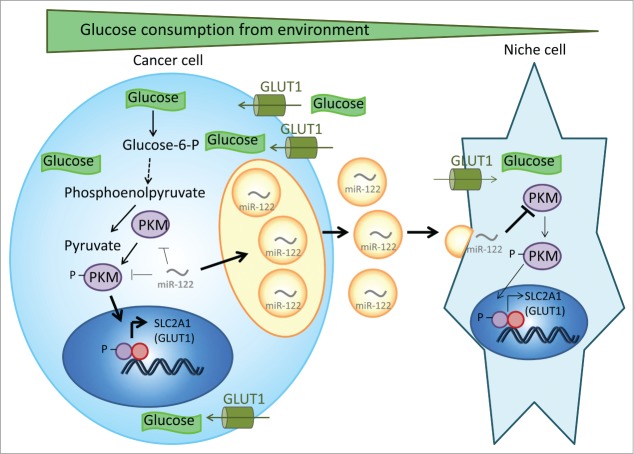Cancer cells consume large amounts of nutrients, largely glucose, in excess of metabolic needs to maintain aberrant growth. Converting all of glucose to CO2 via oxidative phosphorylation to generate ATP runs counter to the needs of the cell as macromolecules precursors are needed in order to create a new cell, such as glycolytic intermediates for non-essential amino acids synthesis, ribose for nucleic acids, and acetyl-CoA and NADPH for fatty acid synthesis.1 These metabolic features support cancer cells to survive under adverse conditions and serve to promote tumor progression, invasiveness, and metastasis. Therefore, most cancers have developed mechanisms to exploit glucose uptake and flux through the glycolytic pathway.
Glucose uptake is largely regulated by the expression of glucose transporters (GLUT), among which GLUT1 (SLC2A1) regulates basal glucose uptake in all cells and is consistently over-expressed in breast cancer cells. In contrast GLUT4 (SLC2A4) is translocated from the cytosol to the plasma membrane upon stimulation by insulin, while GLUT2 (SLC2A2) expression changes in response to glucose concentrations, such as post-fasting conditions.2 Regulation of GLUT expression in cancer cells is largely influences by increasing expression of oncogenes, including PI3K/Akt/GSK3, mTOR, c-Myc, and hypoxia inducible factors-1 (HIF1). HIF1α levels have also been reported to be increased by an mTOR-dependent mechanism. Importantly, c-Myc and HIF1α encode the same genes of glycolysis leading to increased glucose uptake and metabolic reprogramming.3 On the other hand, loss of p53 promotes glucose uptake by regulating GLUT1 and GLUT4 expression.
While hypoxia results in a shift toward glycolysis through HIF1α stabilization, it also has other important consequences, including stimulating the production of angiogenic growth factors and cytokines to increase angiogenesis, and hence gain nutrients from the blood supply. Furthermore, hypoxia has been shown to increase exosome secretion in breast cancer cells and additionally modulates the extracellular matrix (ECM) remodeling through the secretion of proteins associated with cell migration and ECM degradation.4 Exosome release by breast cancer cells has also demonstrated a pro-metastatic effect through the release of miR-105, which destroys endothelial gap junctions allowing enhanced intravasation and extravasation of cancer cells.5 Furthermore, circulating miR-105 and miR-122 were elevated in the serum of breast cancer patients with metastatic reoccurrence, which urged us to explore the function of extracellular miR-122.6
With these key concepts in mind, we sought to determine if breast cancer could enhance its access to glucose by minimizing the competition by niche cells. Furthermore we asked if this effect could be induced prior to the arrival of circulating tumor cells in order to create an environment to support survival and hence promote metastatic colonization.7 We demonstrated that miR-122 targets the glycolytic enzyme pyruvate kinase (PKM), resulting in down-regulation of GLUT1 (SLC2A1) and consequently glucose uptake. Furthermore, the secretion of miR-122 by cancer cells has 2 important functions: 1) by eliminating miR-122 from the intracellular compartment, breast cancer cells release the brake on PKM and GLUT1 suppression, gaining them the ability to increase their glucose consumption; and 2) by suppressing PKM and GLUT1 in niche cells, cancer reduces the competition for nutrients. The net result of these dual actions results in the increased ability for circulating tumor cells to colonize a new tissue during a critical time when increased nutrients are needed for increased biomass and proliferation (Fig. 1). To demonstrate these concepts, we used 3 animal models: 1) Extracellular vesicles (EVs) injection followed by circulating tumor cell injection, 2) poorly metastatic xenograft mammary tumors with miR-122 over-expression using MCFDCIS.com cells, and 3) anti-miR-122 intervention using highly metastatic xenograft tumors derived from MDA-MB-231 cells. The first and second models demonstrated that high miR-122 levels resulted in enhanced metastasis to the brain and lungs while concurrently decreasing glucose uptake due to modulations in PKM and GLUT1 expression. Importantly, anti-miR-122 treatment in a metastatic breast cancer model demonstrated a therapeutic effect by reducing metastasis to the brain and lungs. We also established that the suppression of glucose uptake in niche tissues is induced in a pre-metastatic stage, providing evidence that this effect is not induced by the metastases but in preparation for colonization of the pre-metastatic niche. MiR-122 intervention was capable of restoring GLUT1 expression and glucose uptake in the brain and lungs. Hence, we have identified an important function of breast cancer secreted miR-122 in promoting metastasis through systemic reprogramming of glucose metabolism, which contributes to the emerging concept that reprogrammed stromal metabolism to manipulate energy availability for cancer cells can fuel metastatic colonization and therefore represents an important aspect in the treatment of cancer metastasis.
Figure 1.
Schematic representation of the secretion of miR-122 in exosomes by cancer cells. The export of miR-122 allows cancer cells to increase their glucose uptake by enhancing GLUT1 expression to support cancer cell growth, while simultaneously suppressing glucose uptake in niche cells. Bold arrows represent the favored pathway.
References
- 1.Vander Heiden MG, et al.. Science 2009; 324:1029-33; PMID:19460998; http://dx.doi.org/ 10.1126/science.1160809. [DOI] [PMC free article] [PubMed] [Google Scholar]
- 2.Macheda ML, et al.. J Cell Physiol 2005; 202:654-62; PMID:15389572; http://dx.doi.org/ 10.1002/jcp.20166. [DOI] [PubMed] [Google Scholar]
- 3.Gordan JD, et al.. Cancer Cell 2007; 12:108-13; PMID:17692803; http://dx.doi.org/ 10.1016/j.ccr.2007.07.006. [DOI] [PMC free article] [PubMed] [Google Scholar]
- 4.Villarroya-Beltri C, et al.. Semin Cancer Biol 2014; 28:3-13; PMID:24769058; http://dx.doi.org/ 10.1016/j.semcancer.2014.04.009. [DOI] [PMC free article] [PubMed] [Google Scholar]
- 5.Zhou W, et al.. Cancer Cell 2014; 25:501-15; PMID: 24735924; http://dx.doi.org/ 10.1016/j.ccr.2014.03.007. [DOI] [PMC free article] [PubMed] [Google Scholar]
- 6.Wu X, et al.. J Transl Med 2012; 10:42; PMID:22400902; http://dx.doi.org/ 10.1186/1479-5876-10-42. [DOI] [PMC free article] [PubMed] [Google Scholar]
- 7.Fong MY, et al.. Nat Cell Biol 2015; 17:183-94; PMID:25621950; http://dx.doi.org/ 10.1038/ncb3094. [DOI] [PMC free article] [PubMed] [Google Scholar]



